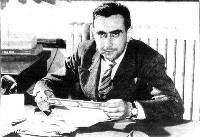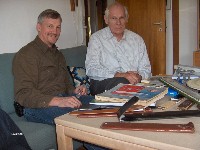|
|

People and Their Slide Rules
Peter Hopp, United Kingdom
The Manhattan Project Engineers
- Edward Teller
- Enrico Fermi
- Enrico Fermi first day cover
The fact that all major design projects and inventions of any note in the 300 years up to the late 1970's must have included major slide rule calculation activity is nowhere better illustrated than the Manhattan Project of World War 2, which produced the atom bomb. Some of the leading lights of that iconic activity were photographed with their slide rules, and we can see that they were significant users of this device.
It is almost as interesting to see who we know used a slide rule but were not photographed (or at least I have yet to find an appropriate image) with a slide rule. Among the people we know were slide rule users is Hans Bethe (1906 - 2005) the nuclear physicist. We know he was slide rule user from his obituary in The Economist of March 19, 2005. He was born in Strasbourg and studied in Munich, Rome and Cambridge before emigrating to the US and Cornell University where he remained except for his time in New Mexico on the Manhattan Project. Bethe continued publishing papers, mostly on black holes and supernovae, well into his 90s, "relying to the end on an old slide rule" to make his calculations. It was, he said, "good enough".
Another of my heroes and also a Manhattan Project star, Richard Feynman (1918 - 1988), Nobel Laureate 1965, must have been a slide rule user but again was not (to my knowledge) photographed with a slide rule. What about Albert Einstein, Robert Oppenheimer and Niels Bohr to name just a few of the others?
However, we do know that Edward Teller (1908 - 2003) was so photographed. The image is from his obituary in the Washington Post in September 2003, where it was said: "Teller...championed efforts to build a defence against the weapons he helped to create." Note the unusual slide rule he used - does anyone any ideas what it was? I have a feeling it is a "Universal" slide rule from Maurice Damien of France (see UKSRC Gazette Issue 3, Autumn 2002) which is perhaps somewhat unusual for an American engineer (Fig. 1).
We also know that Enrico Fermi (1901 - 1954), Physicist and Nobel Laureate in 1938 who also worked on the Manhattan Project was a slide rule user. The Berkeley web site www.arch.ced.berkeley.edu has a pretty terrible picture of him using a slide rule (Fig. 2); I do not know where the picture originated. Fermi is doubly celebrated, the second picture is of a first-day cover celebrating his birth centenary issued in 2001 in the USA - many thanks Ron Knapp for the image (Fig. 3). Whether the images are a true likeness of the man make for interesting speculation, none of the three images seem to me to show the same man.
Incidentally, Fermi was well known for his slide rule virtuosity, a piece in the New York Times "People" column about Professor Gino Segre, Physics Professor at the University of Pennsylvania quoted: "My uncle (Emilio Segre, also a winner of the Nobel Prize (1959) and a Manhattan Project member) remembered Fermi as being able to calculate, very quickly, the order of magnitude of anything. During the war, my uncle worked with Fermi on the atomic bomb at Los Alamos. At the Trinity test site, as soon as he saw the blast, Fermi started ripping up little pieces of paper. At the very moment the shock-wave from the blast arrived, it blew Fermi’s paper scraps away. Fermi then took out a slide rule and said, "Ah, 12,000 tons of TNT." From the papers and his position, he could calculate the explosive power of this new weapon.
This is a bit of a fishing expedition. Does the readership have any images of other Manhattan Project luminaries with their slide rule? Surely such an august band of scientists must have had a major number of slide rule users, and somewhere there must be photos of them with their slide rules.
|


Fig. 1

Fig. 2

Fig. 3
|
Visit to Denmark
Barry Donovan, Rutland, Vermont
This past mid-October, my wife and I were able to travel to Denmark to visit our daughter who is spending this fall semester studying aboard. While the main purpose was to see her and experience Copenhagen, I was curious to find out about slide rules in Denmark. I sent an inquiry to the Dutch Circle of Slide Rule Collectors, via their website. My email went to Otto van Poelje, who forwarded it on to John Kvint.
John responded and we exchanged several emails. I was hoping to find out about any antique/collectible shops that would have any slide rules. John informed me that there really are no slide rules to be had and provided me with a short history on slide rules in Denmark. John was very modest and I did not find out his involvement with Danish slide rules until I was reading Joe Soper’s book, "K&E Salisbury Products Division Slide Rules", where John is mentioned in Chapter Five. He did extend an offer to visit and see his slide rule collection, which I readily accepted.
John’s hospitality was exceptional. He picked up my wife, daughter and me at our hotel and gave us a tour of the countryside on the way to his house. We spent some time viewing his collection, especially the Uto manufactured slide rules. Afterwards, John and his wife, treated us to a traditional Danish lunch in his home, complete with schnaps.
After lunch, we gave them a gift of Vermont maple syrup that was made near our home town. John surprised me greatly by presenting with me several Uto slide rules from his collection. This was a very pleasant and informative day for me and it was all made possible through the common interest in slide rules and the Internet.
|


Barry Donovan and John Kvint in Denmark
|
Sighting of the Johannes Holland Spiral Slide Rule - Dating 1650
Ed Chamberlain, Etna, New Hampshire
I was very surprised to find this early spiral slide rule during my recent trip to then UK for the International Slide Rule Meeting - IM2008. After the meeting a group of us from the former colony visited the Whipple Museum in Cambridge to see its slide rule collection. The major attraction was an early Oughtred "Circles of Proportion" slide rule made by Ira Allen. While looking for the Oughtred slide rule, a very large brass disk with a spiral scale caught my eye. It was signed by "Johannes Holland fecit et donauii Anno Dom 1650 & 1667. It was also labeled "Circuli Proporiionum Logariithicj" in Latin. This was another "Circles of Proportion" slide rule, but not the Oughtred slide rule that I was looking for.
Upon returning to the US, I was able to get photos of the Holland instrument from the Whipple Museum and a description of the device from their catalog. Josh Nall [1] of the Whipple wrote me that: "The object has been on loan to the Whipple Museum since 1951, and is the possession of Trinity College, Cambridge." Nall also wrote that our catalogue for the Holland instrument records the serpentine (spiral) scale as "after the design of T. Browne". This was another revelation! I had been searching for an example of one of Thomas Browne’s spiral scale slide rule designs for a long time without success. Browne was credited by Oughtred as being the inventor of the serpentine scale and maker of instruments with such scales as early as 1631. No examples of his spiral scale instruments are known. All that we know is that Browne made circular slide rules with serpentine windings of 5, 10 or 20 turns. Now with the Holland instrument, we may have an example of one of his spiral scales.
The Holland disk is made of brass and is about 14.6-in diameter. It is missing its cursors, so we do not know what they looked like. The spiral scale is actually a set of three scales - number, sin and tan - that winds its way outwards on the disk for a total of 11 windings. Curiously, the number scale starts with the second winding and runs from 10 to 100 for 10 revolutions. I estimate the actual scale length to be about 18.3-ft (5.6-m) and the effective scale length [2] to be about 32.3-ft (9.7-m). Four digits can be resolved at both ends of the scale.
With the finding of the Holland spiral slide rule we may now have an example of Browne’s serpentine scale calculator. Certainly it is the oldest known slide rule with spiral scales, has the longest spiral scale known to made before the Fearnly in 1881[2], and is on the largest diameter disk known for spiral slide rules. I am now working on the provenance of this slide rule and trying to figure out some details and how it went unnoticed to the slide rule collecting community. I have not shown a picture here because I first needed to get authorization from (and pay a fee to) the Whipple Museum, but did not have sufficient time.
[1] Nall, Josh, Whipple Museum, Cambridge, UK, personal communication, Oct. 2008
[2] Chamberlain, Edwin, "Circular Slide Rules with Very Long Scales", Jour. Oughtred Soc., v.17, n1, 2008, p. 52-64
|

|
|
|
|